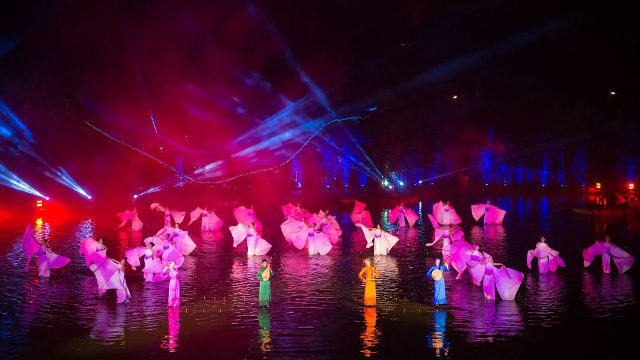



The stage is permanently submerged under a thin layer of water, and is large enough to accommodate all 250 performers at any one time. (Photo: tinhhoabacbo.com)
The Quintessence of Tonkin, run by Tuan Chau Ha Noi JSC, impressed the judges of the Asia-Pacific Stevie Awards 2018 with images of peaceful landscapes and its depiction of the unique heritage of the northern region as well as Vietnamese history and culture from a contemporary perspective, which it portrayed with the help of hundreds of performers, an interactive stage, and state-of-the-art technology.
The Silver prizes for this category went to Traditional become Modernism - Korea traditional theatre Miyaljeon by Seoul’s Dure Art, "Hoi An Memories” show at the Hoi An Theme Park in the central Vietnamese province of Quang Nam, and Toonation, a project by the Republic of Korea’s Toothlife Co. Ltd.
The Bronze went to Hong Kong’s HGC Global Communications for their Launch of New eSports Online Platform project.
The Quintessence of Tonkin highlights various elements of Vietnamese culture, such as folk singing, folk games, the worship of Mother Goddesses, and the daily life of farmers, portrayed in contemporary and innovative ways.
The 60-minute show is held every day between 7.30 pm and 8.30 pm at Baara Land, Quoc Oai district, 25km west of Hanoi’s centre.
The venue is near the Thay Pagoda, one of the oldest Buddhist pagodas in the country and a pilgrimage site during the lunar new year festival season.
The spectacle draws inspiration from the pagoda’s spiritual history, with its story focusing on the founding of the pagoda by the venerable monk Tu Dao Hanh and the ancient union between religion and monarchy. A visit to the Thay Pagoda can be combined with a trip to see The Quintessence of Tonkin, contextualising both experiences.
The show’s stage was built between the auditorium and the small hill where Thay Pagoda rests, so audiences can watch the show with the pagoda as a backdrop.
The stage is permanently submerged under a thin layer of water, and is large enough to accommodate all 250 performers at any one time.
The water allows for a creative portrayal of the area’s cultural heritage, in the form of water puppetry and dragon boat racing, among others.
While performance art technicians were sourced to come up with a world class sound and lighting system, the show reflects the peaceful sounds of rural Vietnam, such as those that come from wooden drums, brass gongs, night crickets, and flowing water. The project also blends different elements of traditional music styles, includingquan ho(love duets) andca tru(ceremonial singing), both of which are now recognised by UNESCO as examples of intangible world heritage.